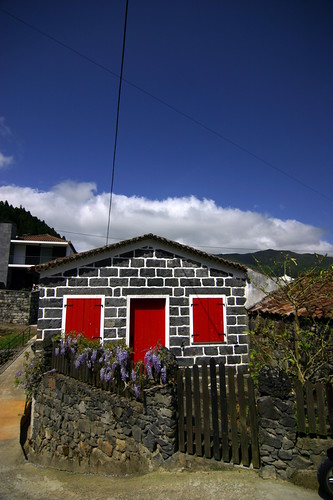Praia da Vitória is the second largest city on Terceira Island in the Azores, located on the eastern fringe of the island. Because it is so close to the American airbase in Lajes and the airport of Terceira, the city often finds itself serving as a base for tourists looking to explore Terceira Island. But few of the island’s visitors ever overlook Praia da Vitória itself – its natural beauty and cultural offerings too conspicuous to ignore. The city offers everything from cliff-sheltered beaches and sheltered dunes, to rustic countryside and old gothic and baroque architecture.

Praia da Vitória was first settled in the 15th century around its natural harbor. The city quickly became an important wheat producing center, as the “Ramo Grande” flatlands of Terceira Island around Praia da Vitória proved extremely fertile. In 1829, the city’s harbor was the scene of a naval battle in the “Liberal Wars” between the Portuguese Liberals and the Absolutists, the former supporting King Pedro IV and the latter supporting King Miguel. After the Liberals won decisively despite the Absolutists’ superior fleet of 21 ships, the town’s original name of Praia was changed by decree to Praia da Vitória (Victory Beach) in order to commemorate the impressive victory. Not too long afterwards, however, Praia da Vitória was partially destroyed by an earthquake in 1841 and had to be rebuilt. Another earthquake hit the city in 1980. Recently, a large oceanic port with a 1,400 meter jetty was completed, which should likely ensure the city’s continued prominence as a strategic port in the Azores.
Today, visitors find enough to see and do in Praia da Vitória. Hitting the beach is one of them; the Praia da Vitória beach is very long, sandy, and one of the most naturally-inviting beaches in the Azores. Needless to say, it is an extremely popular hangout for activities like swimming, surfing, sailing, yachting, diving, snorkeling, tanning, beach partying, and beach barbecuing. Windsurfing is a particular favorite in Praia da Vitória. The city’s seabreeze is strong and sweeping, often edging up against Praia’s low mountain ridges.

Visitors can also check out the city’s magnificent old architecture and landmarks. The 15th century “Matriz” church was the first on the island, founded by Jácome de Bruges, and like the 16th century “Senhor Santo Cristo” church has survived several earthquakes. The fortifications at Santa Catarina, Praia’s historic centre and 16th century town hall, and the lighthouse at Facho are all worthwhile sites as well. The latter was used during the city’s first 400 years as a lookout tower to guard against pirates and enemy ships but is no longer operable today.
For magnificent vista views of Praia da Vitória and its coast, there is a belvedere called Miradouro Riviera, which is located on the cape of Ponta do Cabo. The view atop the Miradouro Riviera circles 360° from Praia’s surrounding countryside to the Atlantic Ocean.

Praia da Vitória was first settled in the 15th century around its natural harbor. The city quickly became an important wheat producing center, as the “Ramo Grande” flatlands of Terceira Island around Praia da Vitória proved extremely fertile. In 1829, the city’s harbor was the scene of a naval battle in the “Liberal Wars” between the Portuguese Liberals and the Absolutists, the former supporting King Pedro IV and the latter supporting King Miguel. After the Liberals won decisively despite the Absolutists’ superior fleet of 21 ships, the town’s original name of Praia was changed by decree to Praia da Vitória (Victory Beach) in order to commemorate the impressive victory. Not too long afterwards, however, Praia da Vitória was partially destroyed by an earthquake in 1841 and had to be rebuilt. Another earthquake hit the city in 1980. Recently, a large oceanic port with a 1,400 meter jetty was completed, which should likely ensure the city’s continued prominence as a strategic port in the Azores.
Today, visitors find enough to see and do in Praia da Vitória. Hitting the beach is one of them; the Praia da Vitória beach is very long, sandy, and one of the most naturally-inviting beaches in the Azores. Needless to say, it is an extremely popular hangout for activities like swimming, surfing, sailing, yachting, diving, snorkeling, tanning, beach partying, and beach barbecuing. Windsurfing is a particular favorite in Praia da Vitória. The city’s seabreeze is strong and sweeping, often edging up against Praia’s low mountain ridges.

Visitors can also check out the city’s magnificent old architecture and landmarks. The 15th century “Matriz” church was the first on the island, founded by Jácome de Bruges, and like the 16th century “Senhor Santo Cristo” church has survived several earthquakes. The fortifications at Santa Catarina, Praia’s historic centre and 16th century town hall, and the lighthouse at Facho are all worthwhile sites as well. The latter was used during the city’s first 400 years as a lookout tower to guard against pirates and enemy ships but is no longer operable today.
For magnificent vista views of Praia da Vitória and its coast, there is a belvedere called Miradouro Riviera, which is located on the cape of Ponta do Cabo. The view atop the Miradouro Riviera circles 360° from Praia’s surrounding countryside to the Atlantic Ocean.



No comments:
Post a Comment